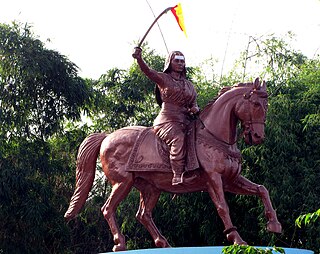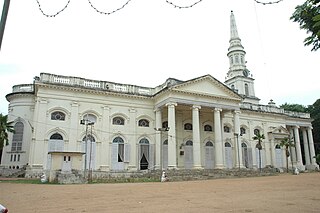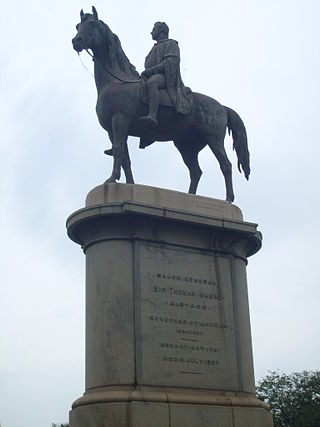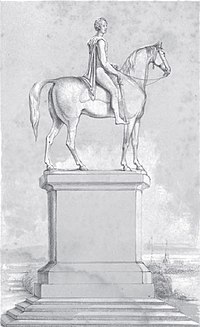
Sir Francis Leggatt Chantrey was an English sculptor. He became the leading portrait sculptor in Regency era Britain, producing busts and statues of many notable figures of the time. Chantrey's most notable works include the statues of King George IV ; King George III (Guildhall), and George Washington. He also executed four monuments to military heroes for St Paul's Cathedral, London. He left the Chantrey Bequest for the purchase of works of art for the nation, which was available from 1878 after the death of his widow.
Malgudi is a fictional town located in Agumbe situated in the Shivamogga district of the Indian state of Karnataka in the novels and short stories of R. K. Narayan. It forms the setting for most of Narayan's works. Starting with his first novel, Swami and Friends, all but one of his fifteen novels and most of his short stories take place here. Malgudi was a portmanteau of two Bengaluru localities - Malleshwara and Basavanagudi.

General Sir Hector Munro, 8th Laird of Novar, KB was a Scottish army officer and politician who served as the ninth Commander-in-Chief of Bengal from 1764 to 1765.

Horace Hayman Wilson was an English orientalist who was elected the first Boden Professor of Sanskrit at Oxford University.

Stanley Medical College (SMC) is a public medical college located in Chennai, Tamil Nadu, India. Though the original hospital is more than 200 years old, the medical college was formally established on 2 July 1938.

Major-General Sir John Malcolm GCB, KLS was a Scottish soldier, diplomat, East India Company administrator, statesman, and historian.

Major-General Sir Thomas Munro, 1st Baronet KCB was a Scottish soldier and British colonial administrator. He served as an East India Company Army officer and statesman, in addition to also being the governor of Madras Presidency.

Sir Alexander John Arbuthnot was a British official and writer.

Kittur Chennamma was the Indian Queen of Kittur, a former princely state in present-day Karnataka. She led an armed resistance against the British East India Company in 1824, in defiance of the Paramountcy, in an attempt to retain control over her dominion. She defeated the Company in the first revolt, but died as a prisoner of war after the second rebellion. As one of the first and few female rulers to lead kittur forces against British colonisation, she continues to be remembered as a folk hero in Karnataka, she is also an important symbol of the Indian independence movement.

Raj Bhavan, literally the "Governor's Residence," is the official residence of the governor of Tamil Nadu. It is located in Chennai, the capital city of Tamil Nadu.

Anna Salai, formerly known as St. Thomas Mount Road or simply Mount Road, is an arterial road in Chennai, India. It starts at the Cooum Creek, south of Fort St George, leading in a south-westerly direction towards St. Thomas Mount, and ends at the Kathipara Junction in Guindy. Beyond the Kathipara Junction, a branch road arises traversing westwards to Poonamallee to form the Mount-Poonamallee Road while the main branch continuing southwards to Chennai Airport, Tambaram and beyond to form Grand Southern Trunk Road. Anna Salai, which is more than 400 years old, is acknowledged as the most important road in Chennai city. The head offices of many commercial enterprises and public buildings are located along Anna Salai. It is the second longest road in Chennai, after EVR Periyar Salai.

St. George's Cathedral is a Church of South India cathedral in Chennai, India. The cathedral was built in 1815. St. George's occupies an important place in the history of Christianity in India, as the Church of South India was inaugurated here on 27 September 1947. It marked the breaking down of ecclesiastical barriers between Protestants of various traditions.

Charnockite, St. Thomas Mount, located to the south of the Chennai city, in Pallavaram suburb, Tamil Nadu, is a characteristically profuse exposure of quartz–feldspar–hypersthene rock, illustrated by occurrence of two pyroxene facies metamorphism.

Raja Sir Savalai Ramaswami Mudaliar (1840–1911) was an Indian merchant, dubash, politician and philanthropist who was known for his wealth. He was also one of the early leaders of the Indian National Congress.

The Island, also called as Island Grounds, is a river island situated on the Cooum River in the northern part of the Indian city of Chennai. The island was created artificially in the early 19th century by merging the Coovum River with the then "Elambore River". An equestrian statue of Sir Thomas Munro, popularly known as "His Stirrupless Majesty", is located on the island. The Madras Gymkhana Club and Pallavan Illam, the headquarters of the Metropolitan Transport Corporation (MTC), Chennai are also located here. The Island Grounds constitute a vast empty space on the island where fairs and exhibitions are held.

General John Munro of the H.E.I.C.S was a Scottish soldier and administrator who served as Resident and Diwan of the States of Travancore and Cochin between 1810 and 1819.
Mani Nagappa is an Indian sculptor who is known for creating statues of prominent personalities and political leaders of Tamil Nadu.

Rajaji Hall, previously known as the Banqueting Hall, Madras, is a public hall in the city of Chennai, India used for social functions. The hall was built by John Goldingham to commemorate the British victory over Tipu Sultan in the Fourth Anglo-Mysore War.

The Triumph of Labour, also known as the Labour statue, is a statue at the Marina Beach, Chennai, India. Erected at the northern end of the beach at the Anna Square opposite University of Madras, it is an important landmark of Chennai. The statue shows four men toiling to move a rock, depicting the hard work of the labouring class. It was sculpted by Debi Prasad Roy Chowdhury. The statue is the earliest one to be erected on the beach and is installed close to the site where the country's first commemoration of May Day was held. The statue was installed on the eve of the Republic Day in 1959, as part of the Kamaraj government's drive to beautify the beach. The statue remains the focal point of May Day celebrations in the city.

The Madras High Court is a High Court in India. It has appellate jurisdiction over the state of Tamil Nadu and the union territory of Puducherry. It is located in Chennai, and is the third oldest high court of India after the Calcutta High Court in Kolkata and Bombay High Court in Mumbai. The Madras High Court is one of four charter high courts of colonial India established in the four Presidency Towns of Madras, Bombay, Allahabad and Calcutta by letters patent granted by Queen Victoria, dated 26 June 1862. It exercises original jurisdiction over the city of Chennai, as well as extraordinary original jurisdiction, civil and criminal, under the letters patent and special original jurisdiction for the issue of writs under the Constitution of India. Covering 107 acres, the court complex is one of the largest in the world, second only to the Supreme Court of the United Kingdom. The four-storey administrative building attracts hundreds of litigants every day.























